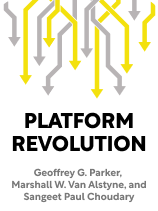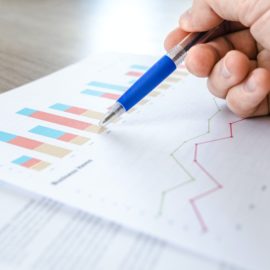

This article is an excerpt from the Shortform book guide to "Platform Revolution" by Geoffrey G. Parker, Marshall W. Van Alstyne, and Sangeet Paul Choudary. Shortform has the world's best summaries and analyses of books you should be reading.
Like this article? Sign up for a free trial here.
What are the differences between the platform and pipeline business models? How do platforms rely on networks?
Geoffrey G. Parker, Marshall W. Van Alstyne, and Sangeet Paul Choudary state that platforms will replace pipelines as the new business model. In addition to facilitating direct producer-consumer connections, platforms differ from pipelines in three important ways.
Let’s explore the pipeline vs. platform business models.
1. Platforms Leverage Network Effects
According to the authors of Platform Revolution, who explain pipeline vs. platform businesses, platforms owe their success to their ability to leverage an economic phenomenon known as “network effects,” where the number of people involved in a market affects the market’s value. To illustrate, compare the social media platforms BeReal and Instagram—BeReal is less valuable than Instagram because fewer people use it. Due to the low quantity of users, there are fewer opportunities for engagement and interaction—the whole point of social media—compared to Instagram.
(Shortform note: “Network effects” is an economics term that’s applied exclusively to the study of markets, but networks have other, non-economic effects, too. In The Square and the Tower, historian Niall Ferguson takes a deeper look at networks to explain how different kinds of networks have impacted world history. For example, Ferguson says that the kinds of networks that proliferate on Western digital platforms are unofficial and non-hierarchical, which has democratized communications and contributed to political instability.)
Network effects can be positive or negative for producers and consumers. For example, if you’re a handyperson on the labor platform TaskRabbit and more handypeople join, you might receive fewer requests for your services. This may benefit you if you receive fewer requests for jobs you lack enthusiasm or know-how for, or it may harm you by decreasing your earnings. An increase in the number of handypeople may also affect the platform’s value to consumers—for example, with more people, a consumer may be more or less likely to find the labor they need, depending on whether the new handypeople have the skills they’re looking for. Parker, Van Alstyne, and Choudary explain that successful platforms account for all of these variables and leverage network effects to maximize benefits for as many users as possible.
(Shortform note: To develop a holistic view of a platform’s network and anticipate the kinds of network effects that might result from a proposed change, you may need to use systems thinking, which Donella Meadows (Thinking in Systems) says requires appreciating how all the parts of a system (in this case, a network) work together. Meadows says you can better understand how a system works via strategies like observation, diagramming, and discussion. Think back to the example we just discussed—if TaskRabbit’s managers wanted to understand the network effects of inviting more handypeople to join, they could observe what users already do, map out the anticipated changes on paper, and discuss the pros and cons of this change together.)
2. Platforms Outsource Operations
Another factor that contributes to platforms’ success is their ability to outsource operations. In pipeline businesses, the business must own or lease the resources needed to create and sell its product to consumers, which is expensive. For example, to sell a wool sweater, a retailer has to buy it from the manufacturer and buy or lease space to store and sell the product. In contrast, platforms outsource operating costs and procedures to the suppliers in their network. For example, instead of buying and paying to store inventory, the secondhand marketplace Poshmark outsources those responsibilities to individual sellers. Parker, Van Alstyne, and Choudary explain that outsourcing makes platforms cheaper to maintain and, therefore, easier to grow.
(Shortform note: Historically, “outsourcing” has typically meant contracting with other companies to build a pipeline—often this was international, as businesses in wealthier countries sought partners whose national laws enabled them to supply exploitatively cheap labor or products. Marxist thinkers explain how large businesses transitioned from outsourcing to cheaper companies abroad to saving money by outsourcing to individuals: Through a process called real subsumption, the demands of doing business in a capitalist society—namely, cutting costs to increase profits as much as possible—slowly transform business methods. Leveraging the labor of a vast network, as eBay did, was more profitable than the pipeline model, so eventually platforms came to predominate.)
3. Platforms Optimize Connections
Finally, Parker, Van Alstyne, and Choudary state that platforms are successful because their design enables them to optimize producer-consumer connections. This occurs in two ways: First, by outsourcing operations, platforms remove barriers to participation. (For example, journalists don’t need to be formally hired by newspapers if they can freely access publishing platforms.) This introduces variety, spontaneity, and innovation into the market, which makes it more likely that consumers will connect with the producers that best meet their needs and vice versa. Second, platforms utilize user data to ensure that the connections they recommend are relevant to users’ interests, enhancing the value they offer to both producers and consumers.
(Shortform note: Using journalism as an example, we can see that although optimizing connections has clear benefits—like users seeing more relevant content—it also has disadvantages. One disadvantage is that by removing barriers to participation, platforms can inadvertently lower the quality of products offered through its platform. For example, loosening restrictions on journalistic sources can lead to the dissemination of disinformation. Another disadvantage is that by using data to deliver results tailored to users’ interest, platforms may inadvertently trap users in “filter bubbles,” where they only see news or posts from friends that confirm their political opinions, leading to greater societal polarization.)

———End of Preview———
Like what you just read? Read the rest of the world's best book summary and analysis of Geoffrey G. Parker, Marshall W. Van Alstyne, and Sangeet Paul Choudary's "Platform Revolution" at Shortform.
Here's what you'll find in our full Platform Revolution summary:
- How platforms like Spotify and Amazon became so successful
- What makes platform businesses so unique and competitive
- Tips for aspiring platform entrepreneurs






